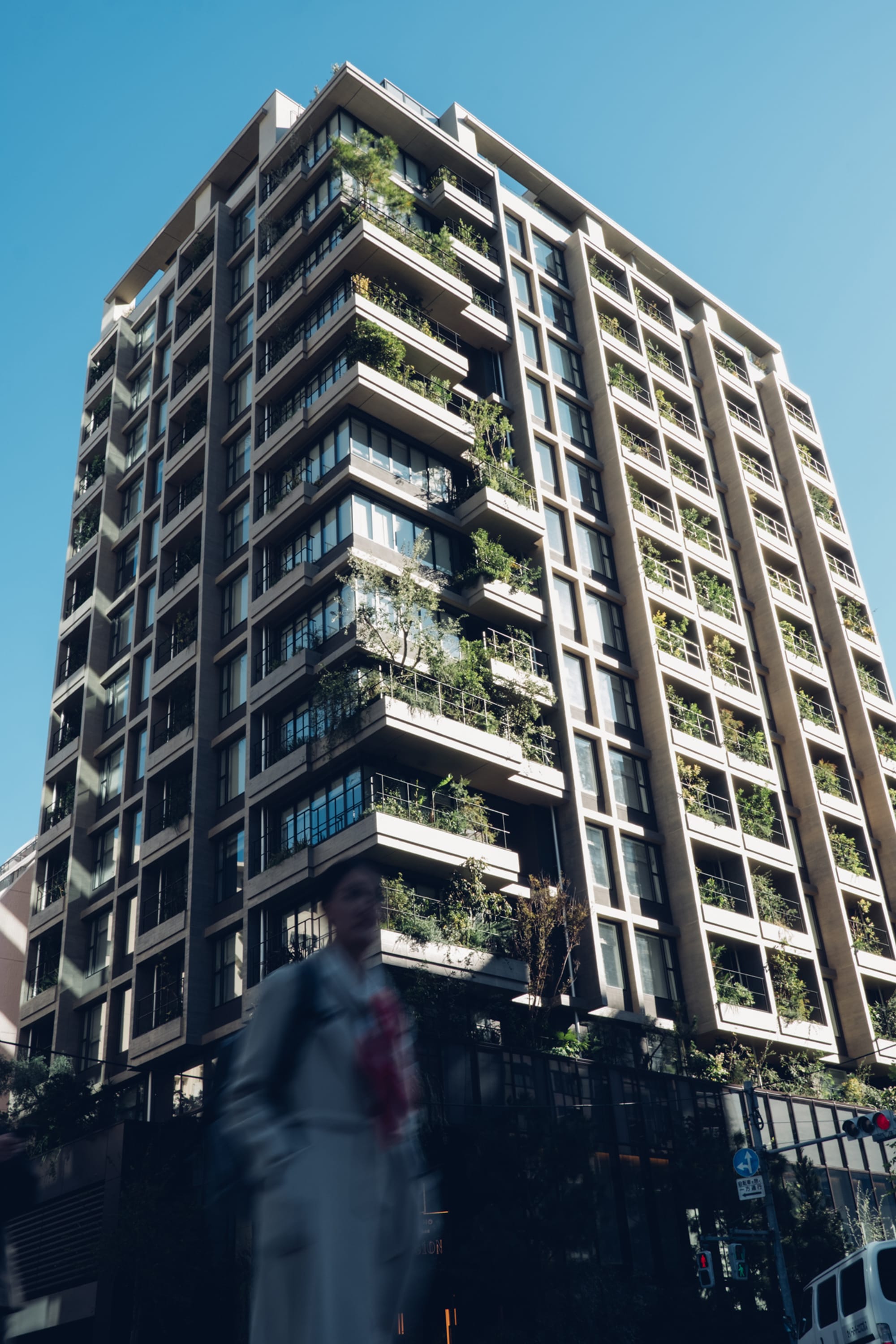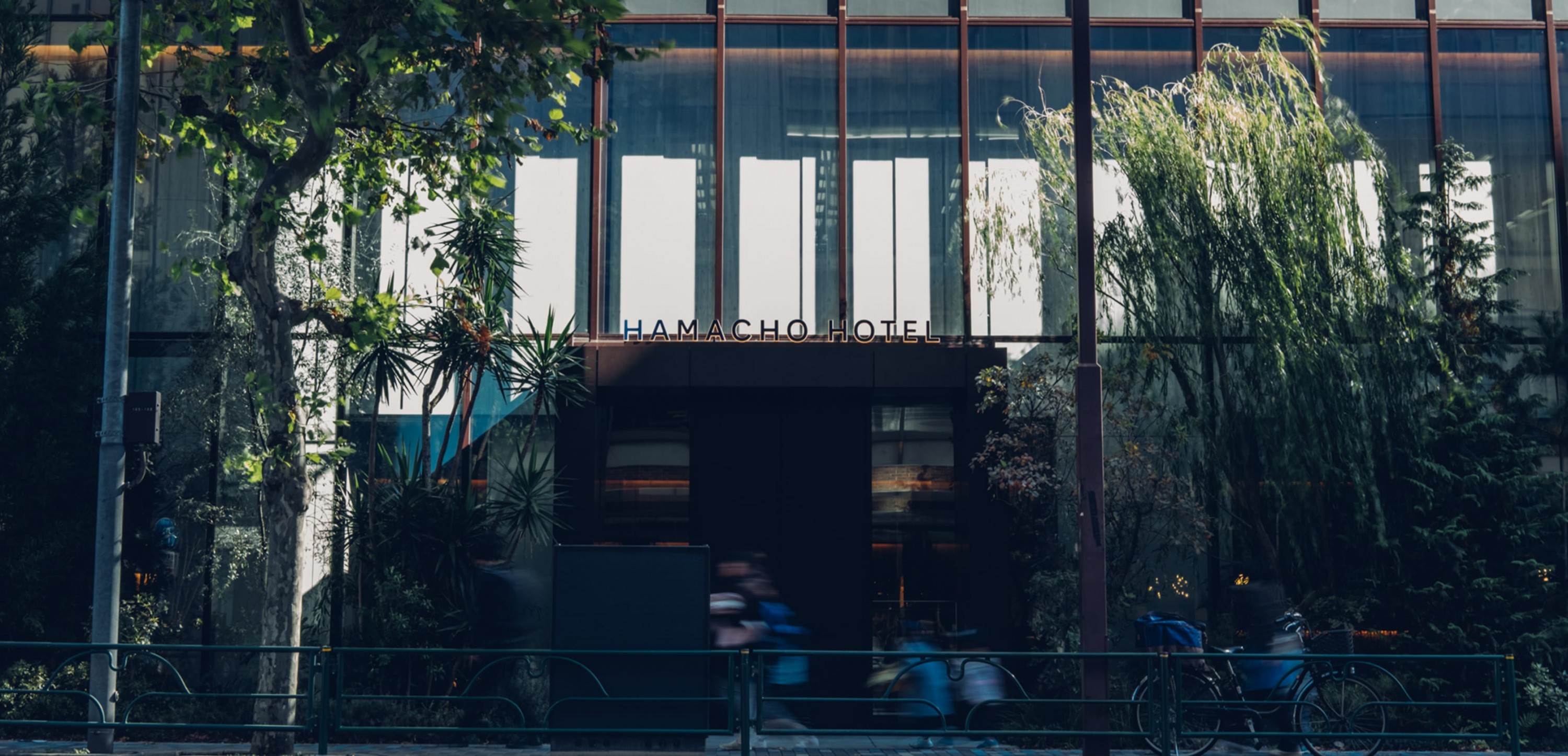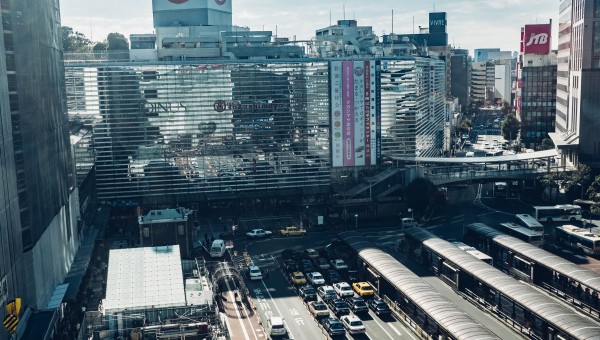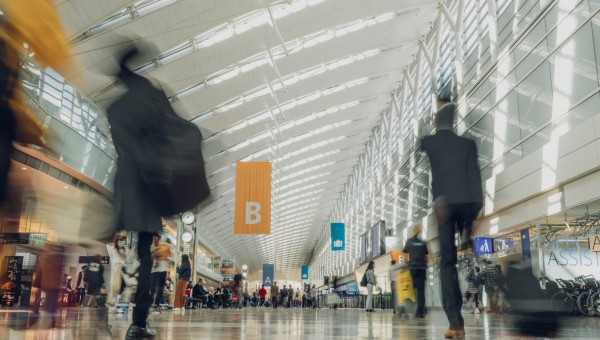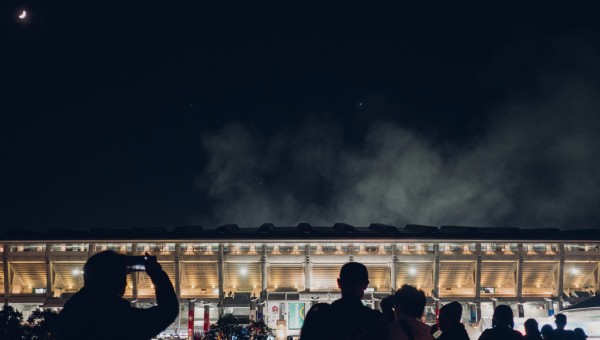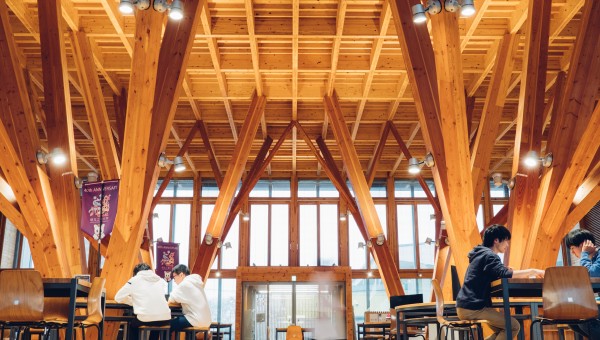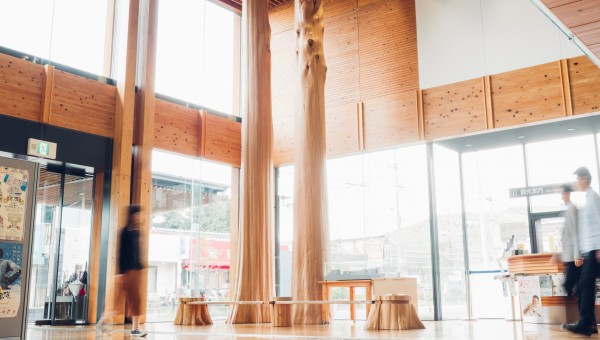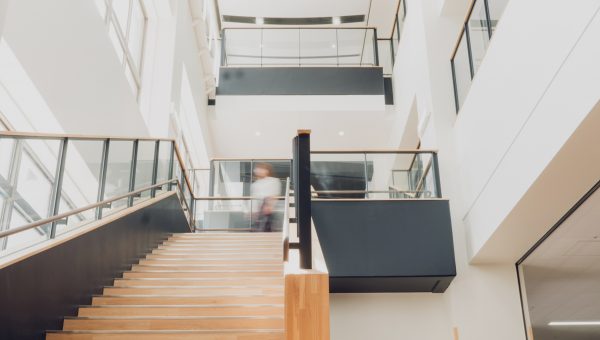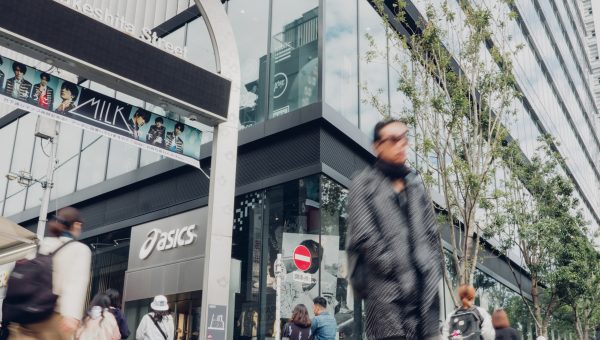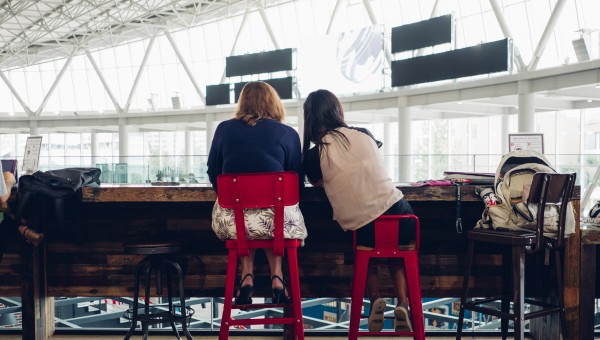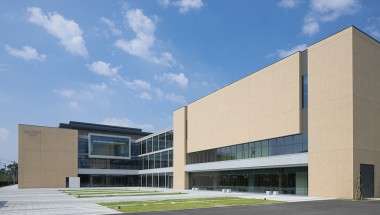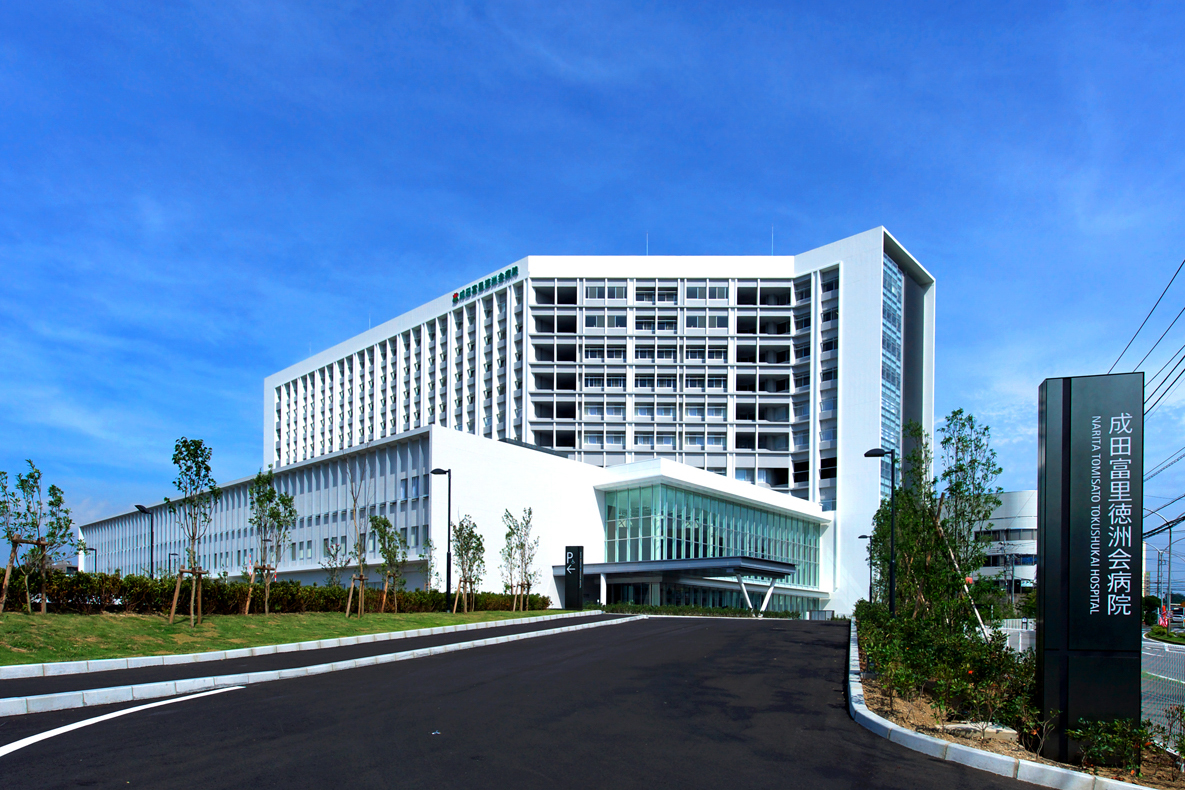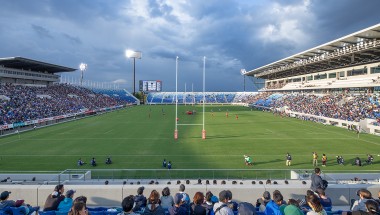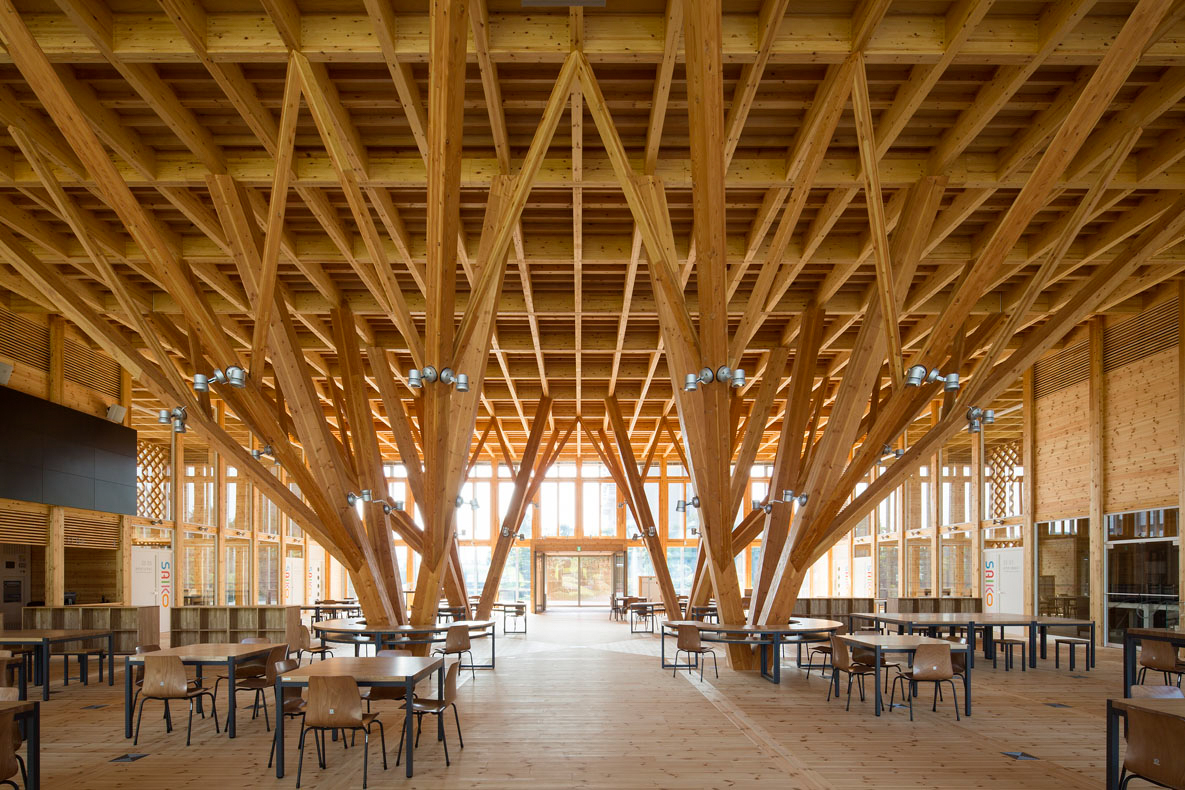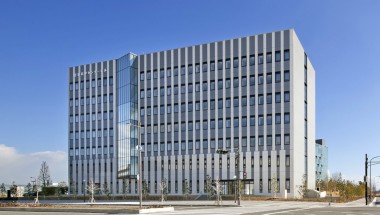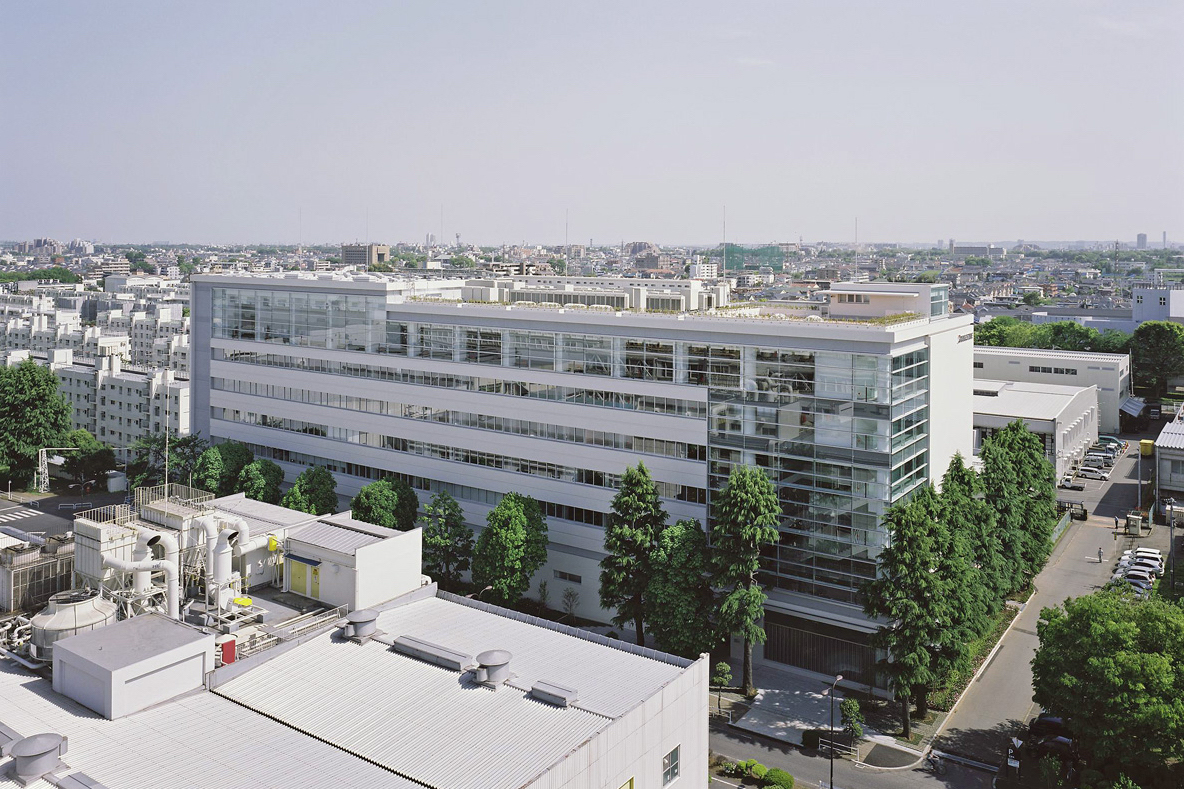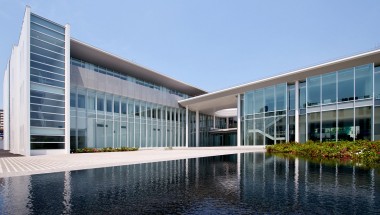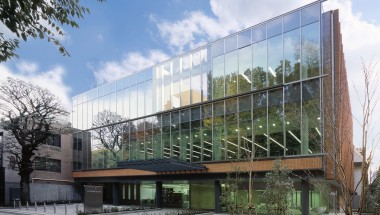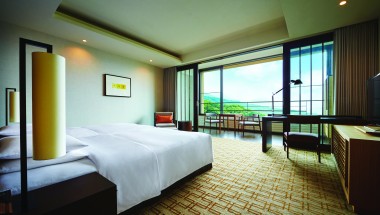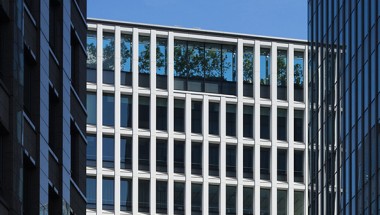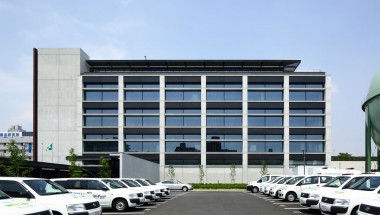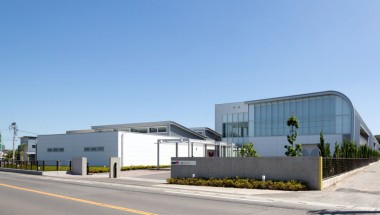A new symbol has been born in Nihonbashi Hamacho, a region known as “The city of craftsmen” since the Edo period.
HAMACHO HOTEL & APARTMENTS is a complex facility combining a hotel, condos, a dining bar, and shops. How does this unique building spice up the city? We asked the people involved.
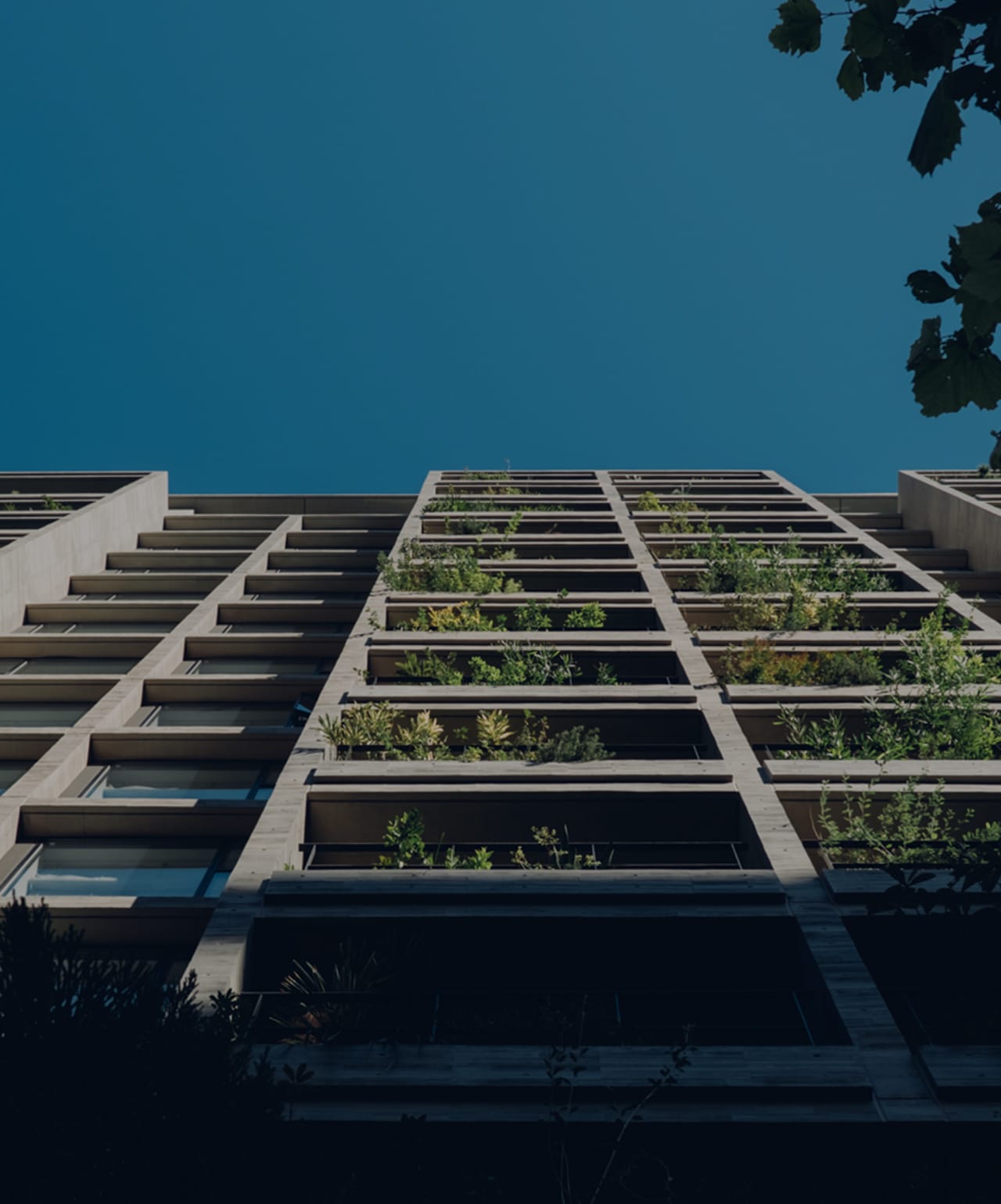
I want to spread attachment to the city,
starting with this building.
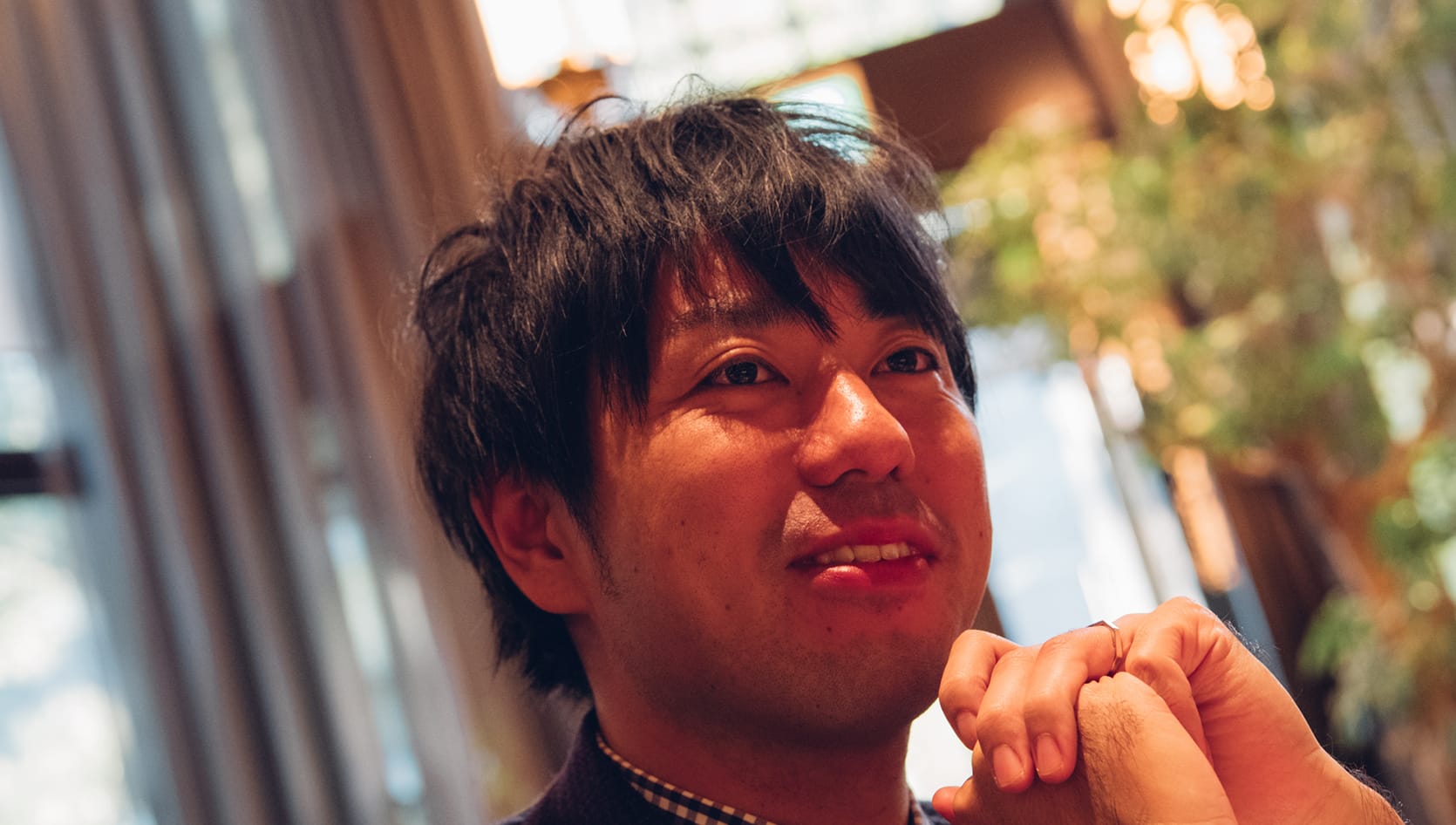
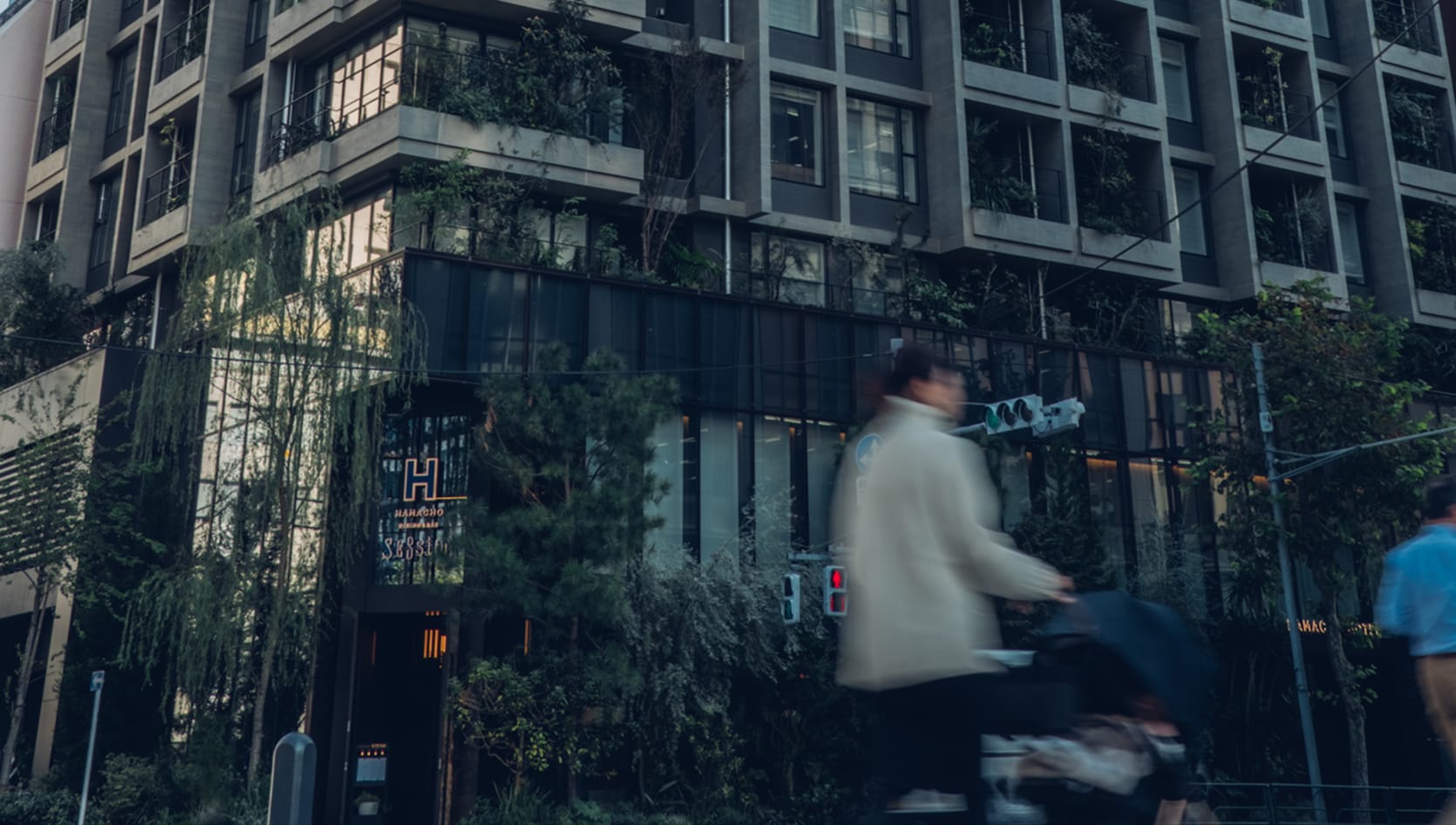
The building just being there livens up the city.
For more than 20 years, we here at Yasuda Real Estate have taken part in development and urban planning in the Nihonbashi Hamacho area. We’ve taken up the slogan “A city of handiwork and greenery” as our urban planning concept. The intersection that hosts HAMACHO HOTEL & APARTMENTS is one location that has lived out that concept, one step at a time. This project was born from the idea that maybe, just maybe, we could put a building at this intersection that will become a symbol for the city. The result was a building that exceeded our wildest expectations.
The biggest features of HAMACHO HOTEL & APARTMENTS are none other than the five-meter-tall tree growing on the balcony and greenery that changes its face with the seasons. The three-dimensional greenery brings a lushness to the townscape. The other keyword, “handiwork,” is expressed in the cedar board framework, a traditional construction method in which concrete walls are covered with cedar wood, and choice materials are brought in to enhance even the finest details.
By producing a unique exterior like no other, the building has become a center of attention for city goers. You’ll sometimes hear the children passing by say to their parents, “I want to stay in a hotel like that.” Just by being there, the building brings excitement to people, and livens up the city. That’s the sort of value we feel this building is creating.
After opening, more people are coming to the city.
HAMACHO HOTEL & APARTMENTS has one more aim: To become the center of excitement for the city. This is not simply rental housing, we’ve incorporated a hotel, a dining bar run by Blue Note Tokyo, Bean to Bar chocolate store, and rooms in which you can view and use products from designers both overseas and domestic, all in order to achieve this goal.
Eight months have passed since the opening, and we can tell more people are coming to the city. The hotel and condos are operating at well above expectations, and we’ve even seen an increase in guests from overseas. The entrance of the dining bar on the first floor is laid out to easily catch the eye of people walking past the intersection, and locals often drop in. The regular live jazz concerts bring guests from overseas and locals wearing kimonos together to listen to the music. This, too, is a sight unique to the traditional Nihonbashi area. Look around you, and you’ll see a group of hotel guests having dinner as a family. It’s become a space where diverse people can have a great time together.
For the future, we’d like to plan interactive events to involve both tenants and local people. Like the live jazz concerts, by regularly holding an event for an extended period of time, culture begins to take root, and this culture is what leads to increased attachment to the city. Both visitors and residents love it here. We’d like to continue that sort of urban planning, centered around this building.
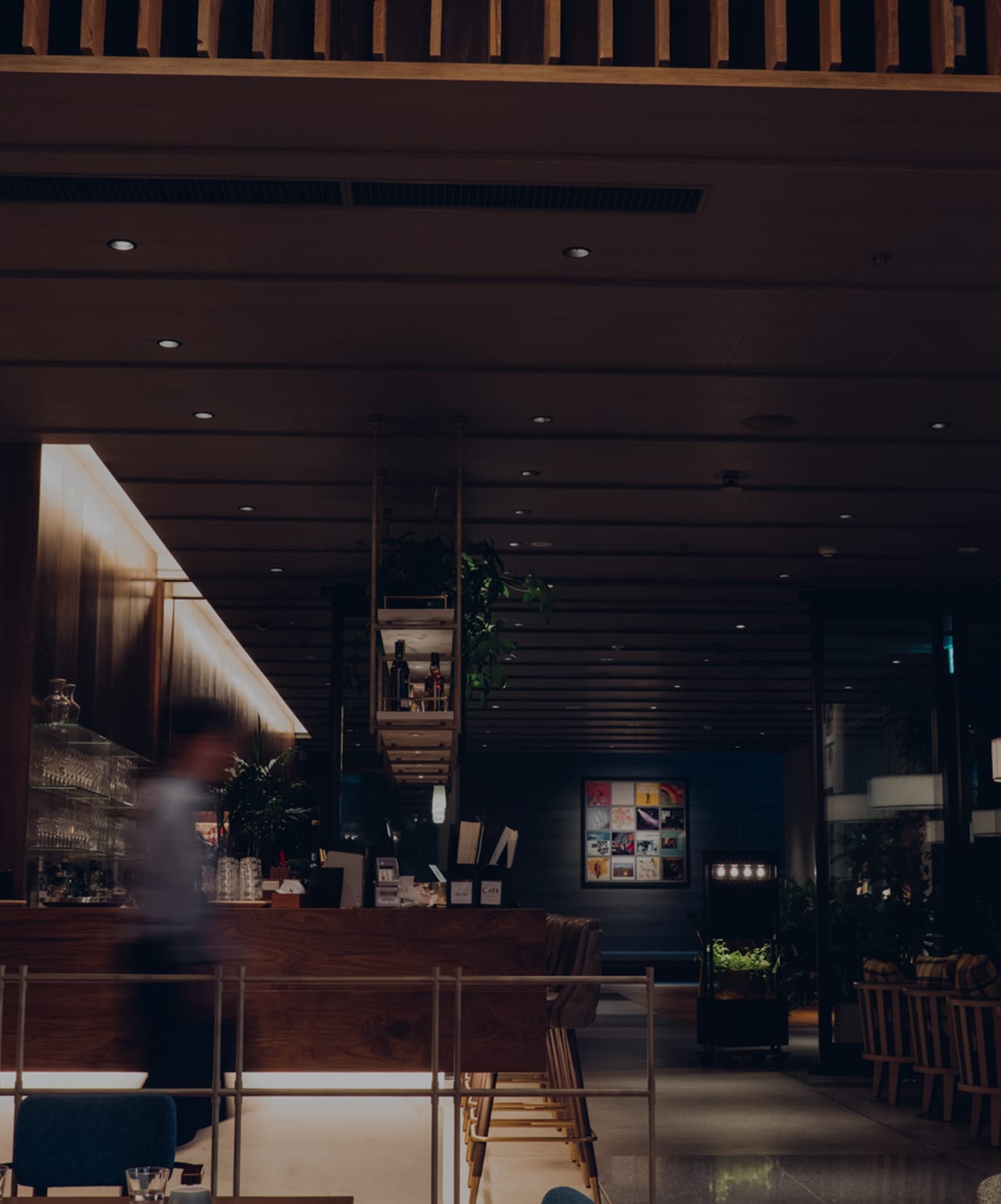
Working with MHS Planners, Architects, and Engineers
enabled our designers to take this challenge.
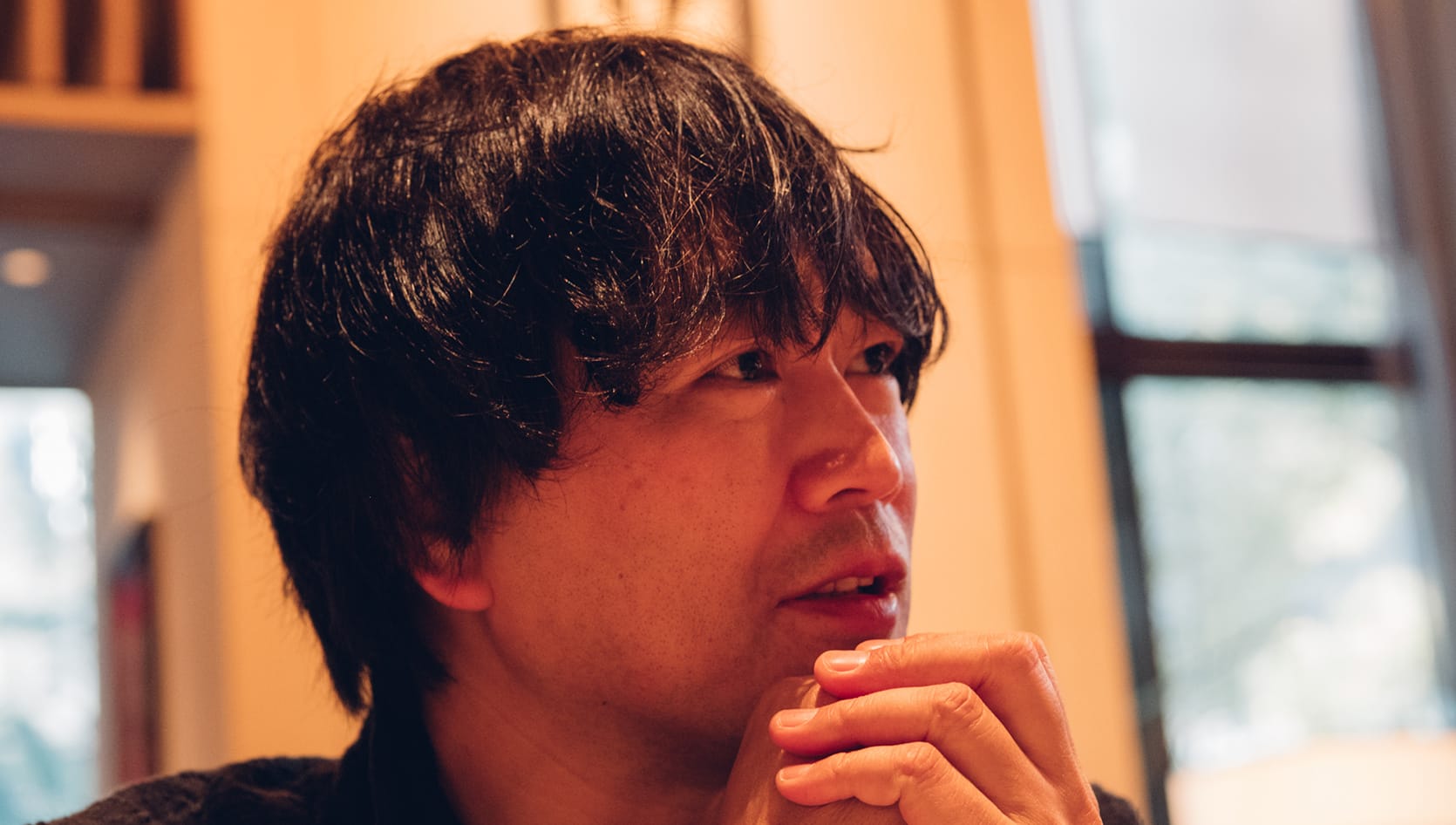
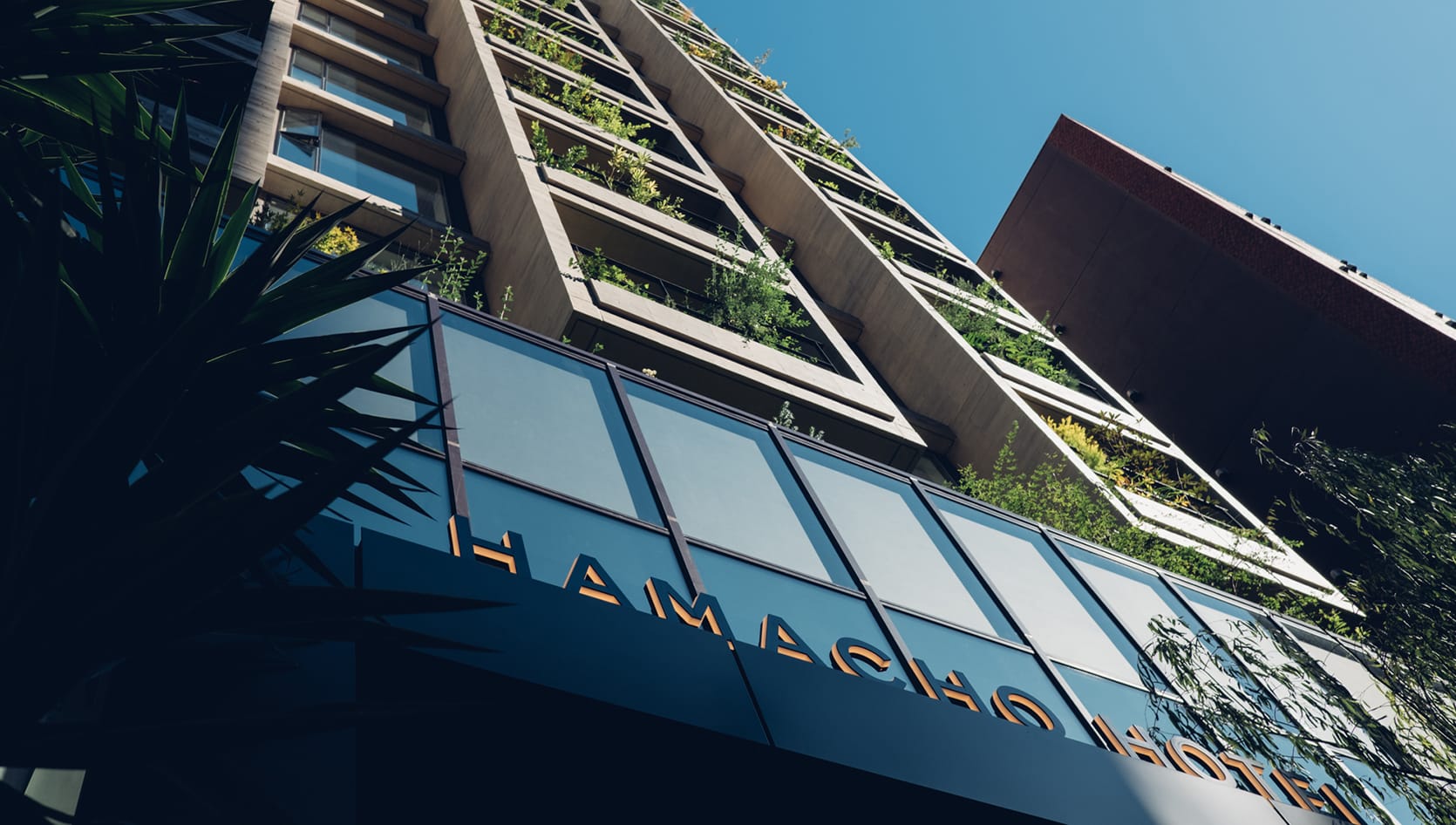
Giving shape to ideas with the height of technical prowess
Our role as designers in this project was to be the “right brain.” We produced one unique idea after another, and brought more and more vitality to the team. MHS Planners, Architects, and Engineers were the “left brain,” processing those ideas logically and giving them form.
Take the planting for example. When buildings incorporate greenery into the design, it’s typically placed on the outside, away from foot traffic, but that’s just not enough to create an impact as a symbol of the city. So, how about planting on the balcony? In fact, let’s plant a five meter tree 30-40 meters off the ground. If we do that, looking out from the inside will give the feeling of being in a resort hotel. When that conversation came up during a meeting, MHS showed us some examples of overseas hotels that used rooftop planting in the facade, and shared some pictures.
We could never have realized such a crazy idea without MHS. We started by cultivating the tree in special soil to ensure strong root growth, then anchored it to the balcony with a double gabion instead of a planter, and made several other tweaks that brought our concept to life. There was a major typhoon that directly hit the building soon after opening, but the planting took zero damage. That was a moment that truly showed the technical prowess of MHS.
They provide overwhelming support, and always pursue the best solutions.
The design for the dining bar made by Ryu Kosaka of Nomura Co. A.N.D. was also impressive. The design had been finished and construction had begun, but then Mr. Kosaka proposed we cut the corner of the building facing the intersection diagonally, and make that the entrance. When I thought about it, he was right, doing that makes the entrance visible from three directions.
When MHS heard this proposal, they changed the design without a moment’s delay, even though construction had already begun. That’s not the sort of decision just anyone can make. The dining bar entrance created by this combination of Mr. Kosaka’s bold idea and MHS’s flexibility has become a “face” for the building that’s well-suited to welcoming many guests.
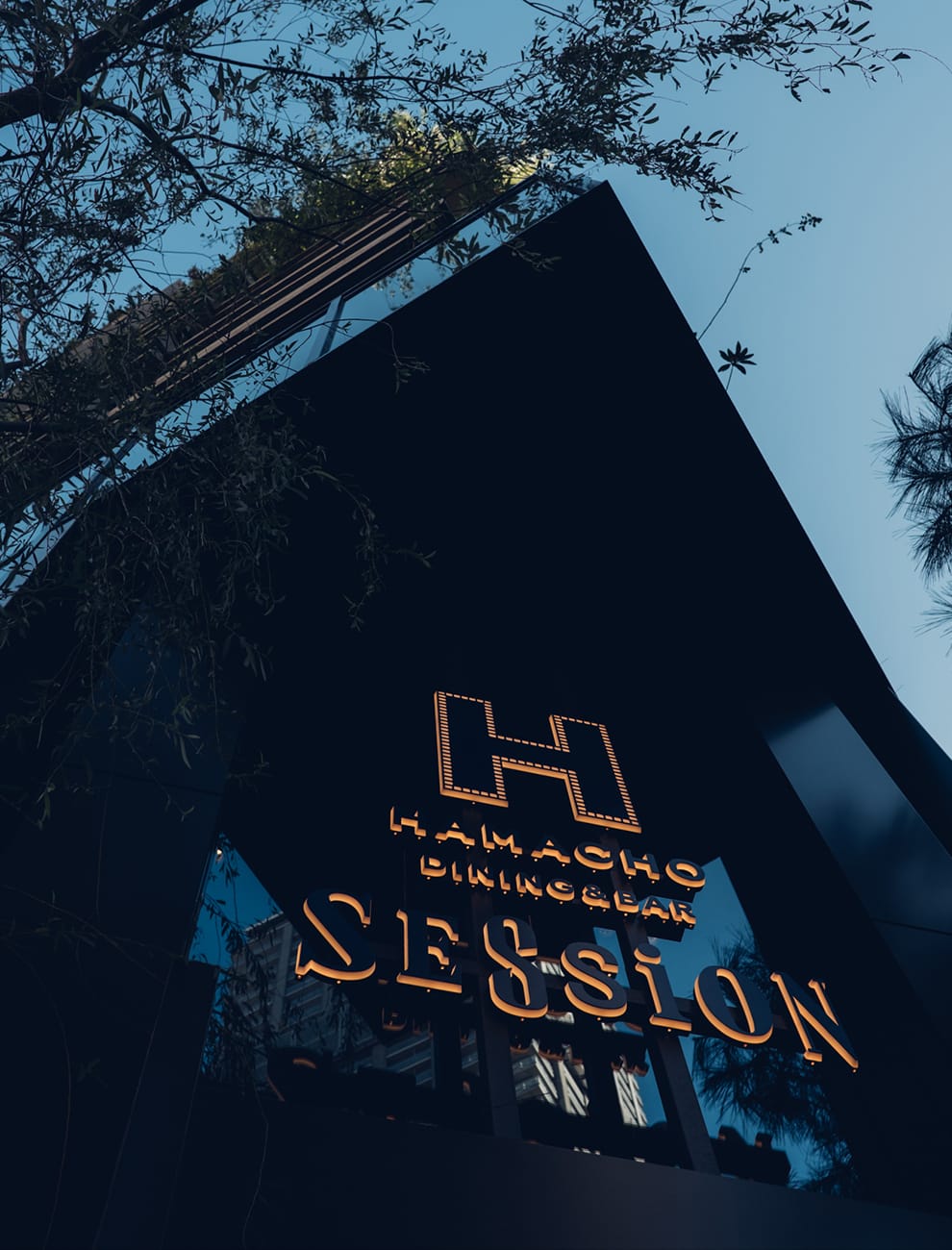
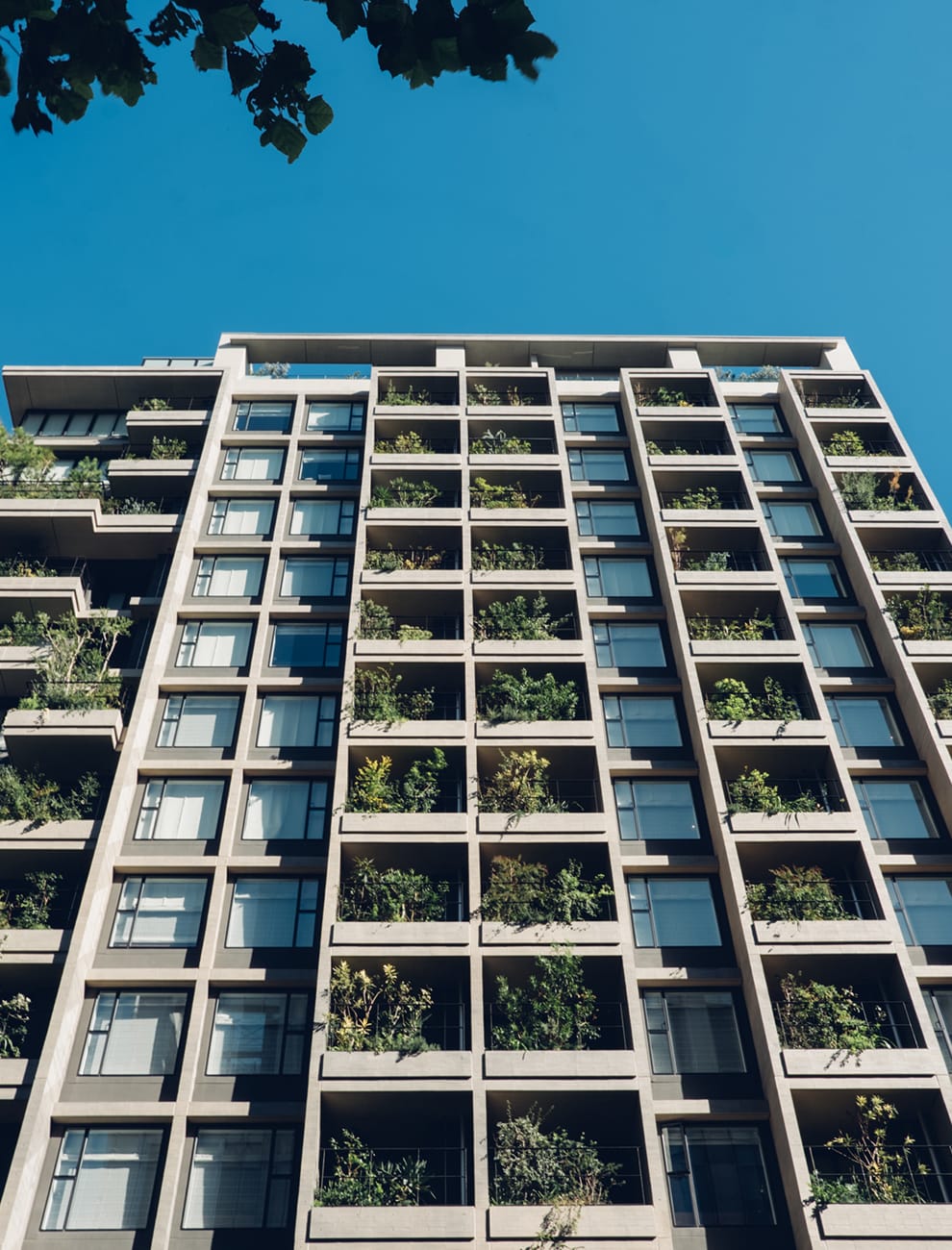
The beautiful interior is also thanks to outstanding designers.
The interior also exceeded expectations. The impression you get from interior design shifts drastically with even a slight measurement change, and the people who ultimately control that are not us designers, but architects. MHS was on top of the numbers for functionality and durability, and took charge with a brilliant sense of aesthetics.
For example, I led the design for the hotel guest rooms, and I proposed we partition them off with raised seating areas and sunken floors which display traditional Japanese architecture. MHS took this design concept to heart, and produced a structurally reasonable design for us. Thanks to them, we were able to unify the room with a contemporary arrangement that allows you to take in the greenery and handiwork while feeling the “Japanese DNA” in the whole room.
HAMACHO HOTEL & APARTMENTS was built by multiplying the “right brain” by the “left brain.” I’d be thrilled if this becomes a facility that makes both foreign guests and local residents think “I want to come back here again.”
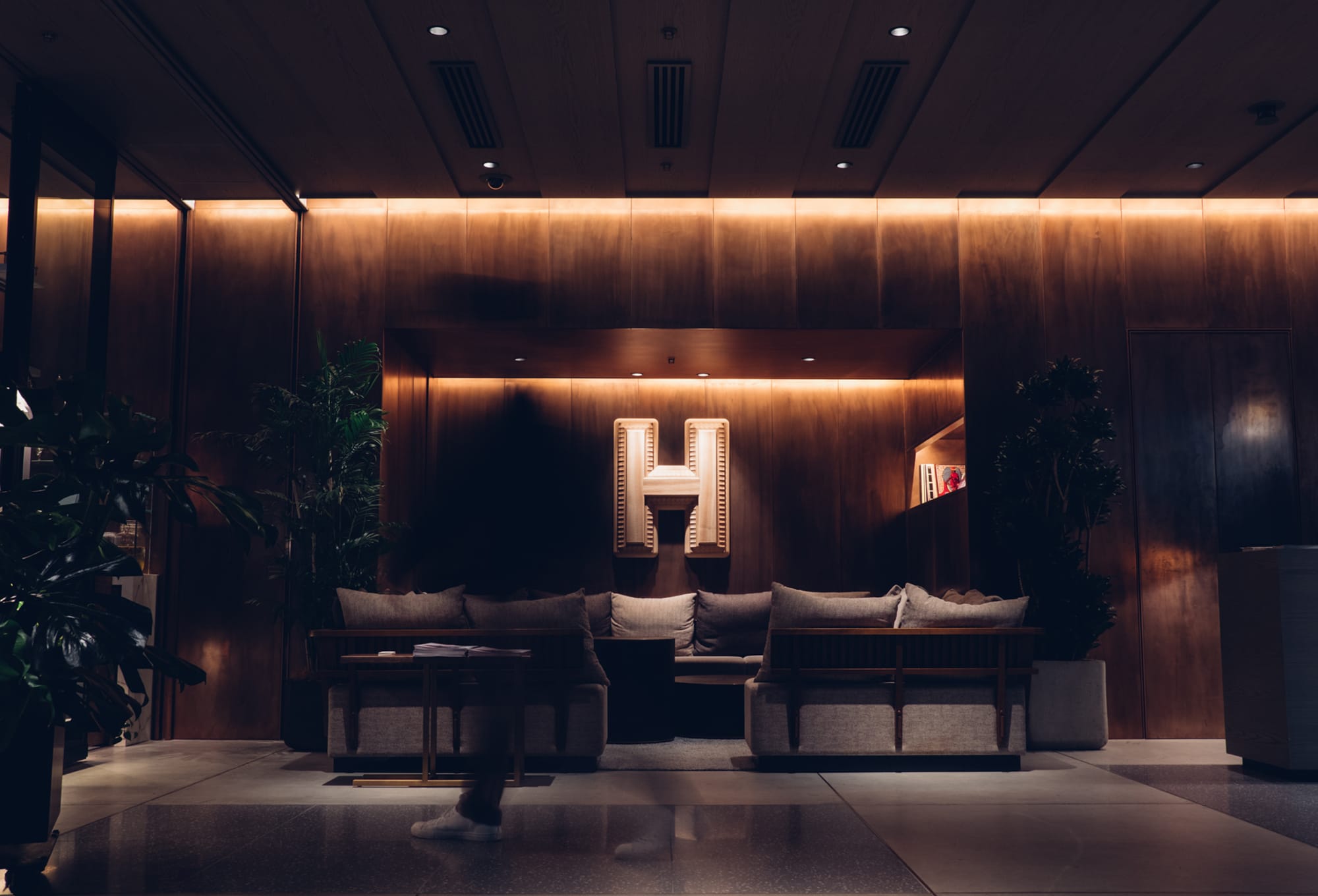
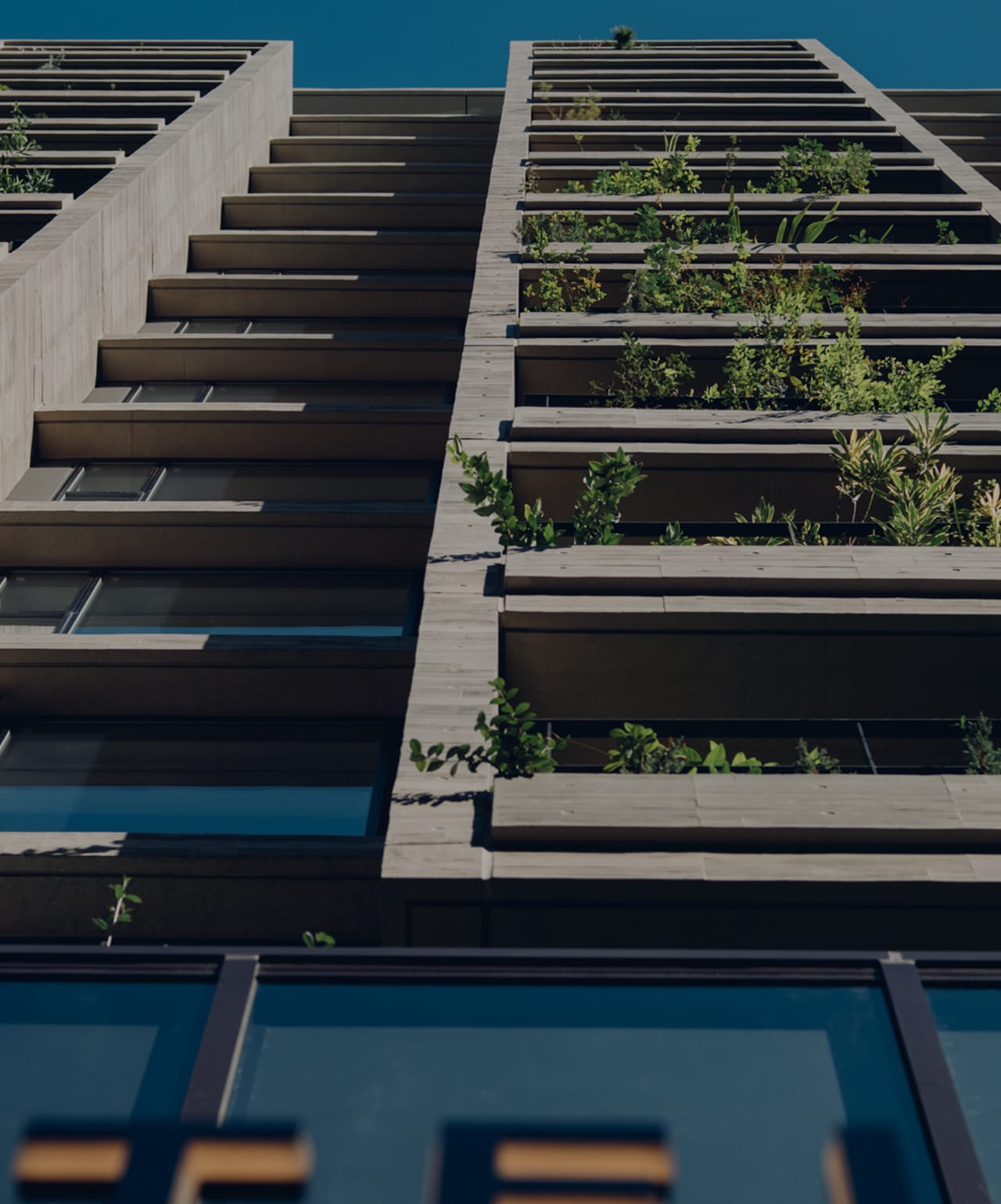
A facility like no other,
with each area subtly connected.
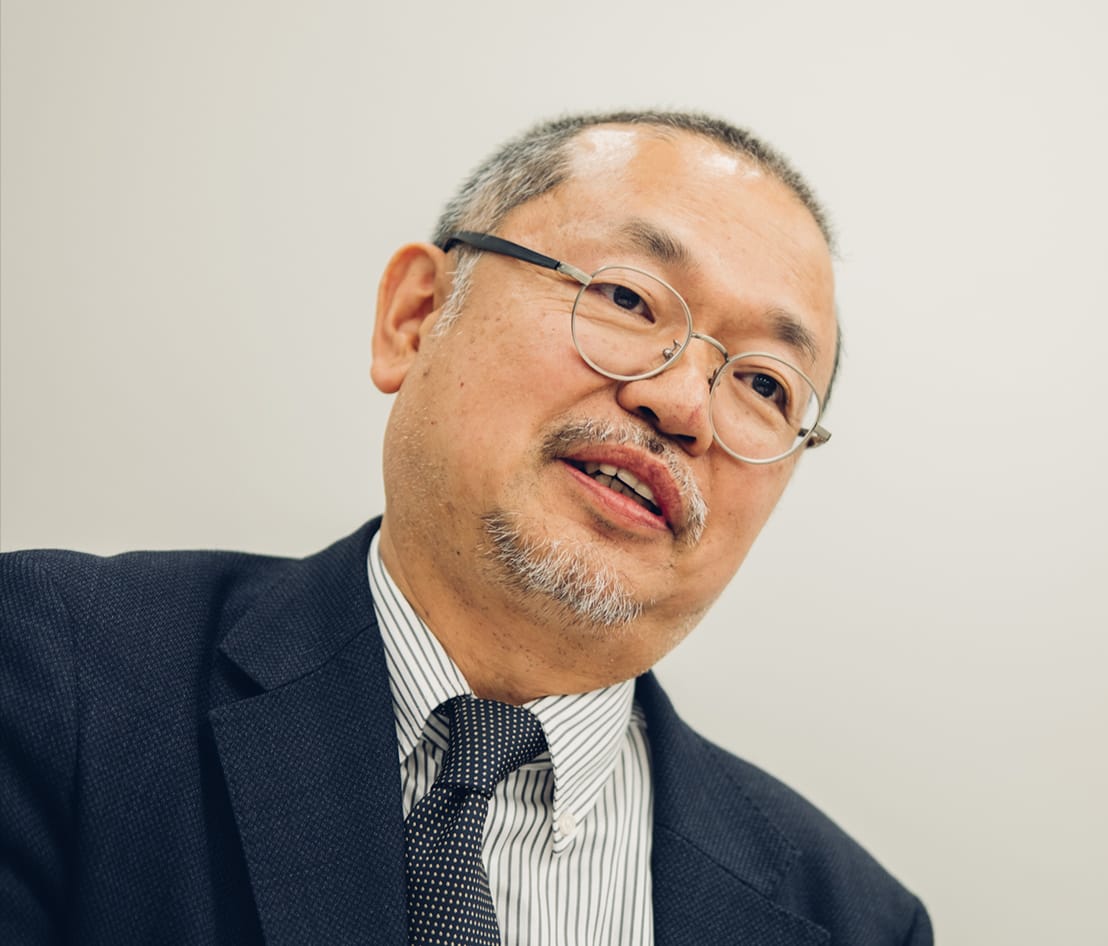
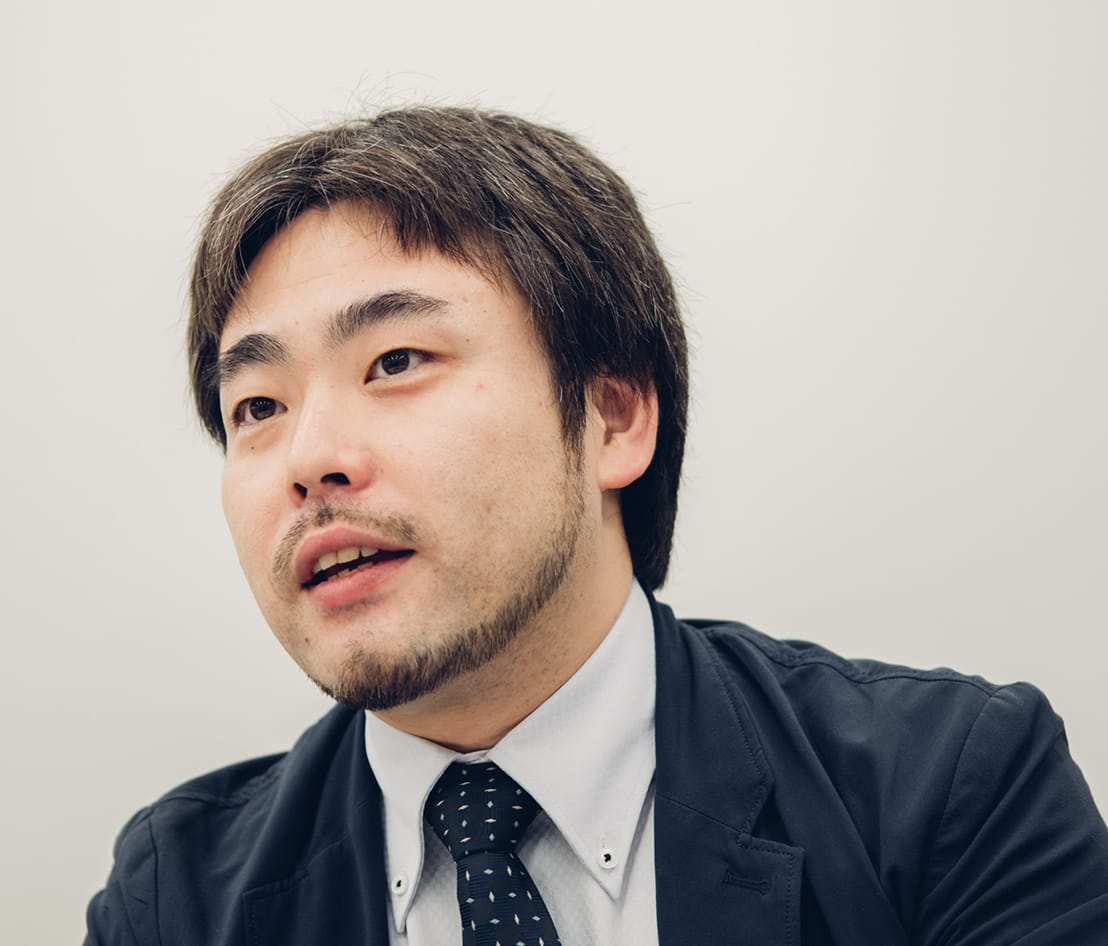
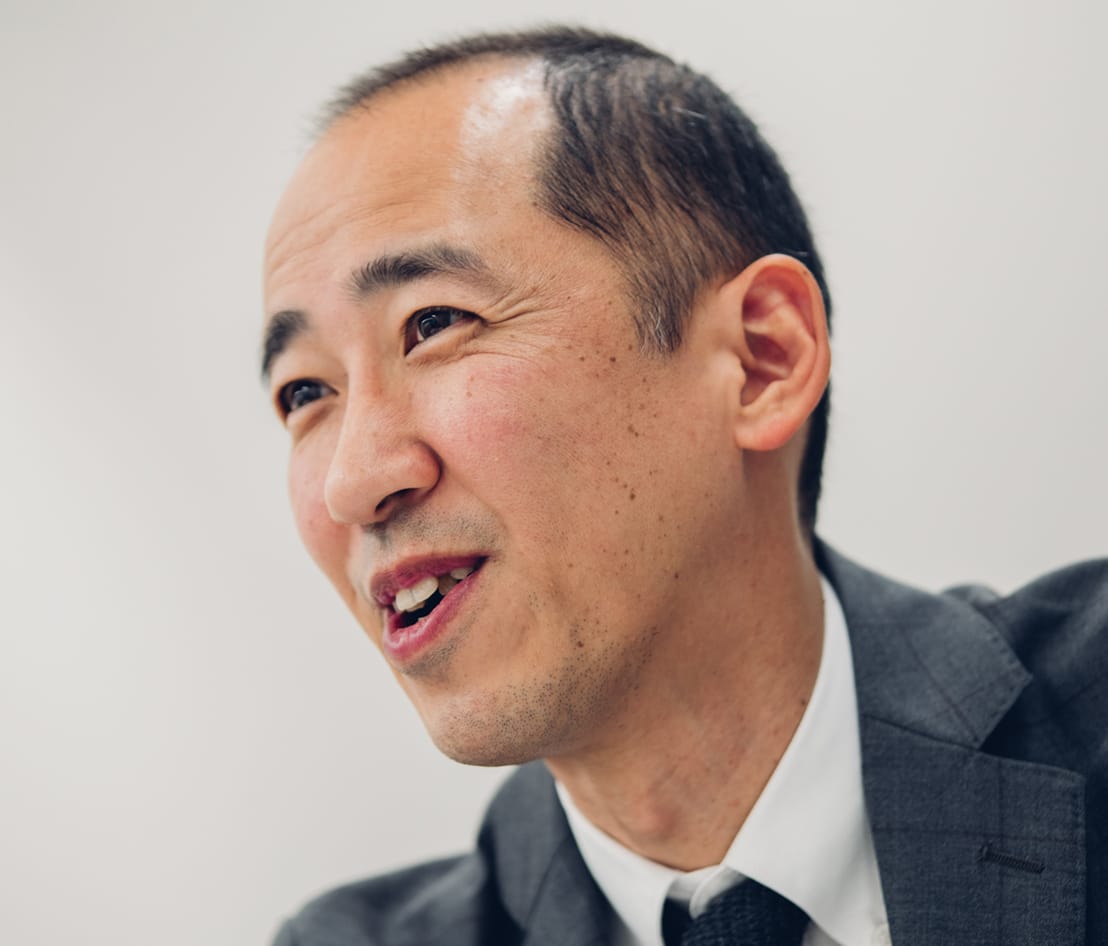
A space for people to interact naturally.
This project began when Yasuda Real Estate came to us about making a building to be a symbol for the city, a “living room” for all to enjoy. When we decided to make it a complex facility combining a number of functions, the first thing we thought about was the building’s architecture. Functions are usually divided up between floors, but that wouldn’t make for an exciting facility. That was when we thought of a flat layout for the hotel and condos. We made good use of the distorted site, put the hotel with a symbolic exterior facing the main road on the northwest side, and spread out the condos on the southeast side that gets plenty of sunlight.
In addition, we joined the hotel entrance to the condo entrance with a connecting hallway called a center array, so the traffic paths intersect. Our aim was to generate liveliness by allowing residents of the condos to use the hotel lounge, dining bar, and shops on a daily basis. As yet another means to liven up the scene, we also separated the hotel lounge from the dining bar with soundproof movable partitions, but these are generally left open to allow the music and friendly chatter from the dining bar to leak over into the lounge. By making the entire first floor into a public space, the whole building gained a new vitality.
A designer’s work is to bring together the strengths of specialists.
Another major feature of this project was the participation of many designers. UDS Ltd and Mr. Takarada of the range design took up the hotel design. The dining bar was done by Mr. Ryu Kosaka of Nomura Co. A.N.D. The “TOKYO CRAFT ROOM,” where designers display and use their productions, was led by Mr. Teruhiro Yanagihara of TERUHIRO YANAGIHARA STUDIO. We’d like to create a feeling of unity across the whole building while fully utilizing each of these richly individualistic designs. All those involved shared the same vision of a subtle connection between each area from the very beginning.
Take for example the hotel entrance and dining bar. The initial designs from Mr. Takarada and Mr. Kosaka were both phenomenal, but when they were lined up, we found that while they were connected spaces, somehow they gave the impression of being two different facilities. How were we going to create a sense of unity? After many discussions, we came to the conclusion that we would match the styles of the ceilings, floors, and walls in each area. By doing so, we were able to preserve the different designs while uniting the whole building, and created one free-flowing space. This sort of adjustment was possible due to our comprehensive involvement at every step of the way.
For the planting, we got help from Ikegami Group, who are highly skilled in planting on buildings, and SOLSO Architectural Plant & Farm, who deal in a wide variety of plants both overseas and domestic. It’s our job to unite the strengths of a wide array of professionals in this way to bring a building to completion. HAMACHO HOTEL & APARTMENTS is one such compilation of expert contributions, and our sincere hope is that it goes on to be loved by many people as a symbol of the city and a common living space for all.
